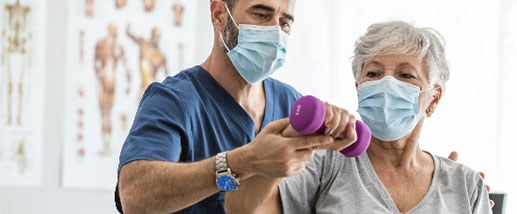The Perfect Fit: Which Shoes are Right for Me?
January 20, 2025
Categories: Health & Wellness, Ask a Doc
Tags: Podiatry
Choosing the right footwear isn’t just only about style or comfort, it has a key role in your overall health. According to the Mayo Clinic, the average person walks 1.5 to 2 miles per day. Without the proper footwear, you can be at risk for back pain, balance problems and even higher risk of falls.
Dr. Bradley Christiansen, Podiatry, Foot and Ankle Surgery, shares some tips on how to the find the proper fitting footwear to put your best foot forward!

Bradley Christiansen, DPM
Podiatry, Foot and Ankle Surgery
Accepting New Patients
View Provider ProfileHow Do I Know My Foot Type?
Bradley Christiansen, DPM: Try this simple test to learn your foot type. Step on a flat surface with wet feet and look at your footprint.
• Flat Feet: If try the water test and see a full footprint, you have flat feet. If you arestanding, look to see if the middle of the inside of your foot touches the groun d. If it does, you likely have flat feet.
• High Arches: Looking at your wet footprint, if there’s no water mark in the middle, you have an arch. You can also notice if there’s a space under the middle of your foot when you stand. This is another sign of an arch.
What Shoes Work Best for My Feet?
Bradley Christiansen, DPM: Remember, the arch support in shoes often comes from insoles, or removeable soles worn inside the shoe, not the shoes themselves. Many shoes come with basic, unsupportive insoles, so adding good-quality insoles can make a big difference.
Based on your foot type, here are some recommendations from Dr. Christiansen when looking for shoes:
• Flat Feet: Look for stability or anti-pronation shoes .
• Neutral or High Arches: Choose neutral or flat-bottomed trainer shoes.
What Problems Can Bad Shoes Cause?
Bradley Christiansen, DPM: Wearing the wrong shoes can lead to problems like:
• Plantar Fasciitis (heel pain)
• Tendonitis (swelling of tendons in your feet or ankles)
• Problems in the knee, hip and back
Shoes and insoles should be replaced after 400-500 miles of use because they lose their structure over time. This can lead to musculoskeletal conditions of the foot and ankle.
Should I Worry About My Foot Conditions?
Bradley Christiansen, DPM: If you have issues like plantar fasciitis, bunions or hammertoes, it’s important to choose shoes carefully. Avoid shoes that are too tight across your feet and pick ones with stiff outsoles that don’t bend easily.
Do I Need Custom Orthotics?
Bradley Christiansen, DPM: Most people don’t need custom insoles. A podiatrist or shoe expert can recommend the best over-the-counter insoles for your foot type.
What Shoes Are Best for Everyday Activities?
Bradley Christiansen, DPM: The shoes you choose for everyday wear should be based on your occupation and the physical demands of your day-to-day activities..
• If You Are Doing More Walking or Standing: Athletic shoes with a sturdy outsole.
• For Those Running or Playing Sports: Brands like Brooks, New Balance, Asics, Saucony or Hoka often work well.
Avoid low-quality, budget shoes that lose their shape quickly, as these can cause foot pain.
How Do I Know If My Shoes Fit?
Bradley Christiansen, DPM: The best way to know if your shoes fit correctly is to visit a running shoe store or a podiatrist to get properly fitted. Your shoes shouldn’t feel too tight or too loose.
Should I Avoid Certain Shoes?
Bradley Christiansen, DPM: Everything is okay in moderation. Shoes like high heels, flat sandals and flip-flops should be worn only occasionally. They can cause or worsen foot problems if worn too often.
Finding the right shoes can keep your feet happy and your body healthy.
If you’re not sure where to start, schedule a visit with a podiatrist to see what shoes are best for you!




